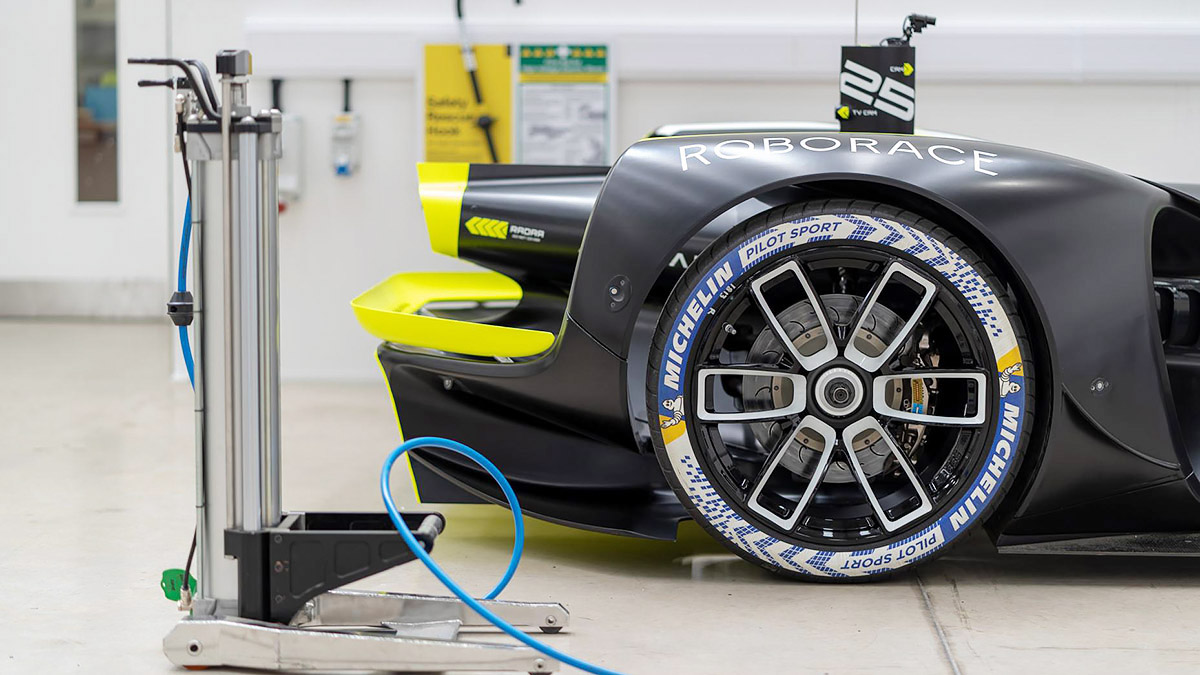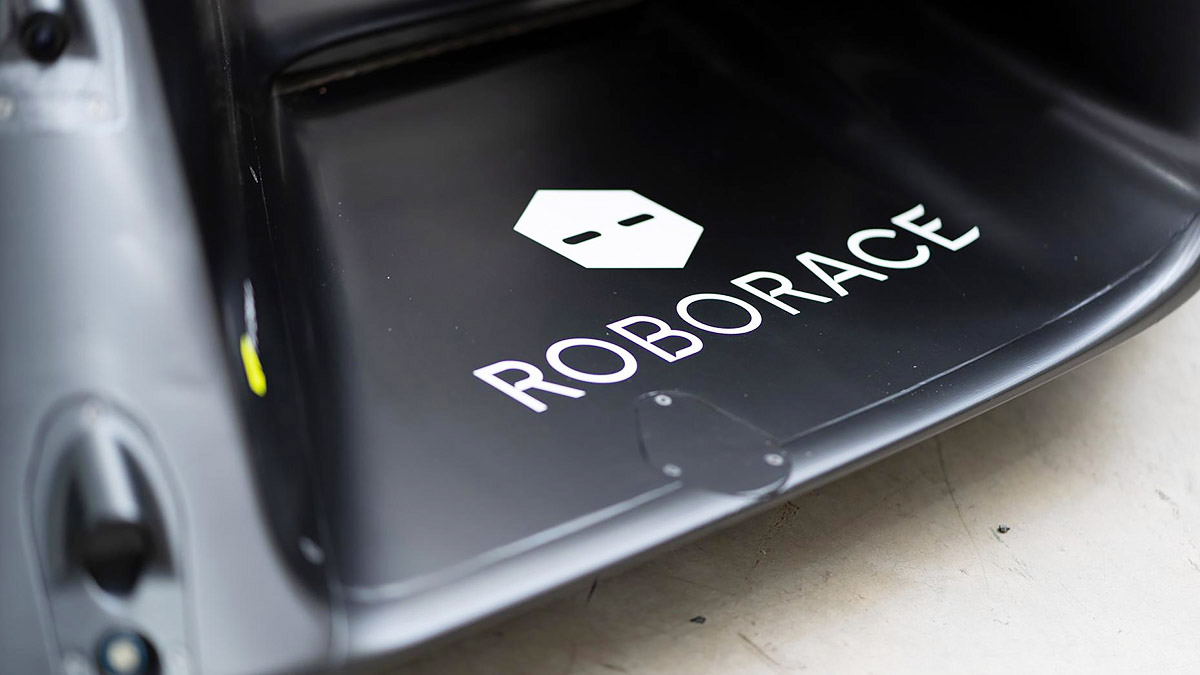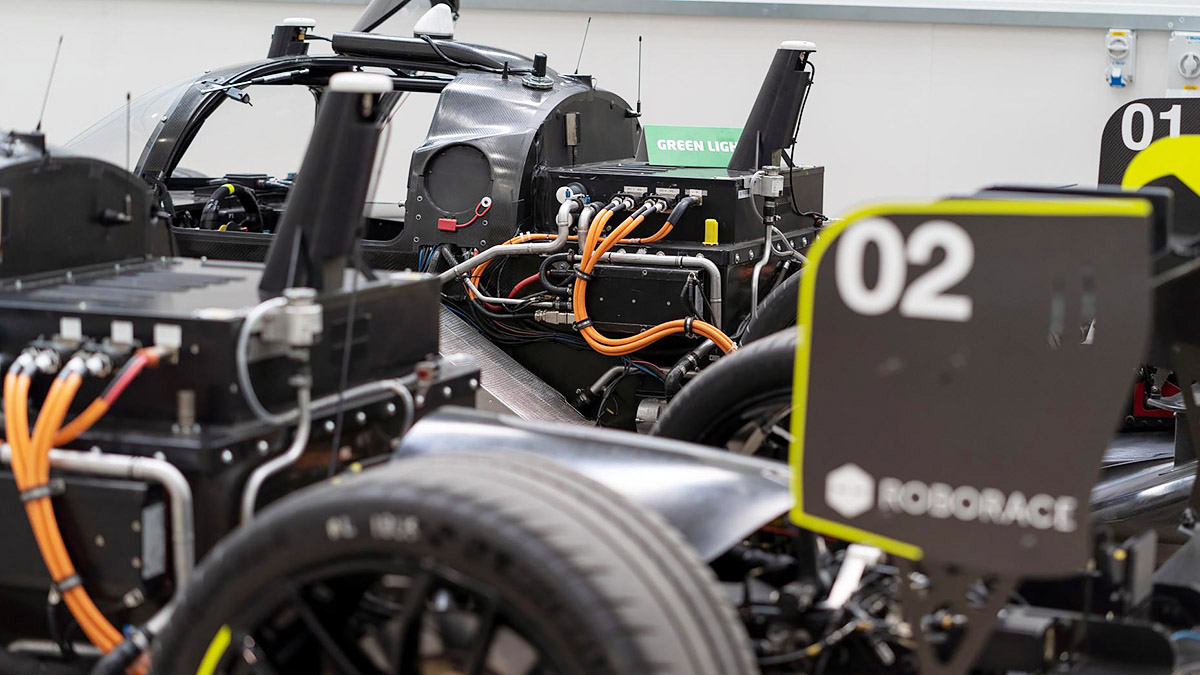
Hollywood’s idea of the future has offered up varying degrees of hope and terror over the years, but one theme has united the strands: artificial intelligence. It’s the one glue that binds this vision together. And, right now, back in our world of cars and motorsport, that glue’s… sticky.
“Autonomous driving has a lot of critics,” explains Daniel Simon. “It’s such a complex technology. If I knew all the answers and how it’ll all pan out, I wouldn’t need to go to work every day.”
Daniel Simon is a designer: a man with previous at Volkswagen and Bugatti, a man who designed the mind-bending machines in the recent cinematic version of Tron, and the man who has designed a vision of an autonomous, futuristic racecar.
The Robocar.

He uses an analogy that feels fitting for our current position on the self-driving timeline. “I love aviation,” he tells TopGear.com. “I remember reading about when the first planes crossed the English Channel, and how – if I was there – I simply wouldn’t have believed it.
“Fast forward to today, where people simply walk onto jetliners not even looking at the plane – they’re on their mobile phones – not caring about the plane, flying around the world with champagne in their hands.”
“Right now, we’re in the time with autonomy that in aviation they were when they just crossed the English Channel. People are scared of it.”
Certainly, there was an air of magic and fear when Roborace’s Robocar made Goodwood history by piloting itself up the famed hillclimb course, in one successful sweep. Repeatedly. No human driver on board. Just a bank of sensors, electric motors and an AI brain guiding that futuristic fuselage past thousands of spectators.
A car designed by a Hollywood artist with artificial intelligence, in our time. Yeah, consider us interested. TopGear.com went behind the scenes to learn about what this car represents for both motorsport, and the wider car world…
It all started with a look into the future
Bryn Balcombe is the chief strategy officer for Roborace, and notes a conversation between Roborace founder Denis Sverdlov and Formula E boss Alejandro Agag. “They were looking at the future,” he tells TG, “and how to enhance the Formula E experience. The future is going to be electric – box ticked with Formula E – but it’s also going to be connected and autonomous.
“So how does motorsport play a role in developing those technologies?”
The first priority was to create something breathtaking
“It needs to be clear that it’s an autonomous car from the beginning,” explains Bryn. “It needs to look completely different to anything else that anybody has seen.”
Over to Daniel. “While we juggled with different ideas of using existing cars, we decided that this is a unique opportunity to create something where you have to hold your breath for a minute, and understand this is something new.
“From a distance,” Daniel adds, “you have to understand that no human is inside controlling it.”
He says his design wasn’t inspired by a specific animal, but admits it was ‘emotionally driven’. “I was looking for something where it is sucked onto the tarmac. The way we achieved that was by angling the four surfaces downwards from the wheels, so the fenders, they actually angle down to the fuselage. We don’t have a human in there so the fuselage is very low.
“That naturally gives this idea of, let’s say a cat – like a tiger – getting ready to jump, head down, shoulder blades up.
“These are things that you don’t really talk about when you do it, but it’s hardwired in everybody’s understanding of appearances,” he adds.
It still had to conform to some existing points of reference. “It has to have a regular size,” Daniel explains. “We wanted to be relevant for production, so doing anything that is arguably much smaller wasn’t the point. We wanted to be road relevant.”
The tech spec is lightly mind-blowing
“We talk about three layers of the vehicle,” Bryn explains. “The hardware platform, the intelligence platform, and the AI driving software.” Hardware is your powertrain, chassis and aero.
Deep breath. “There are four independent electric motors,” Bryn tells us, “with 135kW (181bhp) per motor. There’s also 300Nm in each motor, so in terms of pure power and torque, it’s very highly specced.” Add them all together and you get something around 725bhp and 1,199Nm of torque.
Oh, and it was aerodynamically honed in Williams’ wind tunnel. “We’ve been there multiple times,” Bryn explains.
The intelligence platform is a bank of sensors, of which there are many. There are three cameras at the front (two that act like wing mirrors) and one at the back, two LiDAR sensors at the front, on the side and one at the back, and radar sensors front and rear. There are also 15 to 18 ultrasonic sensors dotted around the car, “almost like parking sensors”, Bryn tells us.
And packing that all up into that astonishing body shape was no small feat. “We’re aiming for level 5 autonomy,” Daniel tells us, and placing all those cameras and LiDARs and so on was difficult when the mission was to make it “skinny everywhere”

It’s got missile accuracy
One part of the ‘intelligence platform’ is the GNSS unit, which is a fibre-optic gyro that’s so accurate the team “have to get export licence restrictions for it”, Bryn explains. Why?
“Because it could be used to guide missiles. This is kind of like a missile on track, effectively,” he adds.
Daniel echoes this analogy. “We slimmed the design down to a torpedo-like centre fuselage, which was really hard for us to package. It’s still kind of large – we need actuators, batteries, space for cooling… that was a massive challenge.”
The processor uses the same core chips as gaming PCs
There’s an NVIDIA Drive PX2 on board. “It is custom made for automotive,” says Bryn, “but obviously uses the same core chips as boards in a graphics card for a gaming PC.
“At launch, they said it was equivalent to 160 laptops,” he adds. The next generation of this chip they’ll move onto later in the year will be ten times as powerful. You do the maths.
The engineers come from motorsport… and university
There are between 40 to 50 people working in Roborace, and – understandably – most hail from the world of cars and motorsport. “We’ve got people here who have previously worked in Formula 1 for a long time – they know the industry inside out,” says Bryn. “Equally we have really good talent fresh out of university.”
The development cycles of around 12-18 months also mean that “Robocar and DevBot always stay at the pinnacle of tech”, according to Bryn. “These are research development units, so it enables the researchers who are working on this platform to be at the cutting edge.”
Robocar is more than just a car… it’s a discipline
Bryn says the team have spoken to the “entire industry, which would include pretty much every OEM you could name”, along with ‘tier one’ suppliers and university PhD research groups about the project.
Why? “The industry is struggling with talent. The big shortages are software engineers who can write the code. One of the core principles of Roborace is to provide an environment to develop their talent.”
Remember those three layers of the Robocar we mentioned earlier? The third is of course, the AI driving software. “This is really where the teams in our sport compete,” Bryn says. “It’s how you take sensor data, process that, build up a 3D model of the environment and choose your racing line and respond to the other ‘drivers’.”
Speaking of competing, Roborace is targeting a 2019 series
The team have already managed two cars on track (though at the Buenos Aires test, they, um crashed). “At the moment, we have vehicle to vehicle communications so we can share data between the cars,” Bryn says. And here’s where it gets mighty technical…
Bryn equates the driving functions of a human as 1) building up a model of the world and your place in it (physically, not spiritually), and 2) making decisions on that data. “In an autonomous vehicle that’s perception, and motion planning,” Bryn said. “You can completely bypass the perception layer by sharing positional data between the cars, but that only works when we rely on the GPS inertial system. Which is great when you have clear sky.
“But go to somewhere like Hong Kong [ie, a built-up area], it’s not going to work. At that point you rely on the perception layer. LiDAR, cameras. That’s really the challenge we’re setting for 2019 – to be able to do two-car interaction when we don’t have good satellite coverage,” he adds.

It’s possible to programme different driving ‘personalities’ into Robocar
“We have been asked if those old F1 names can come back into the sport,” Bryn says with a smile. “Like, ‘can you have Ayrton Senna come back and drive one of the Robocars, and then compete against Lewis Hamilton’.
“Or compete against an e-sports star who’s been in a simulator, and you’ve copied his driving style and put it into an AI driver,” he adds.
These personalities won’t deliberately be coded into the cars, mind. “We can get the car to a level of a Niki Lauda on track, but maybe not the James Hunt off the track!”
DevBot might become its own entertainment spectacle
As with any new car, there was a development mule used to test the hardware and software. That’s called ‘DevBot’. It took six months to build the first one, using a modified tub from Ginetta.
The motors, inverters and powertrain are exactly the same as Robocar, but with a slightly de-rated battery. Oh, and there’s space for a driver in there, too. “That’s what makes it really interesting as a platform,” Bryn says. “You can manually drive and build up a map of the environment. You set lap times, and then try to beat that with the AI.”
Eventually, this tech could be used to assist or even augment the human driver, allowing the AI “to make an amateur driver perform at a much higher level”. We’ve come full Matrix here, people.
On top of that however, Bryn envisions a bigger role for the hardy little development mule. “There’s real entertainment and development value in DevBot. It’s now getting a refresh, so a lot of the things it did as a mule, it’ll now become its own product.
“Think about DevBot like you would Formula 2, with Robocar being Formula 1,” he says.
It’s quick, too. Bryn reckons it’ll do a sub-three second time from 0-97kph. “It’s got a ridiculous amount of torque,” he said.
Daniel agrees on the little mule’s promotion. “I’m very fascinated with putting a human aspect into it. I really like the idea of these simple formats of a human setting a lap time and the autonomous mode tries to beat it. Or you work together in a team mode.
“We’re working hard to be entertaining.”
There’s a 10 to 20 per cent difference in lap times between human and AI
Depending of course, on the quality of the human driver. The reason the AI is a bit behind is because of safety. “Particularly when we run at Formula E tracks,” Bryn says, “you’ve got concrete barriers, which is great for LiDAR, but if you’re out by a centimetre you’re going to knock a wheel off.
“At the moment we leave a safety margin of around one metre to the barrier. Now, imagine a human racing driver leaving a metre margin, they’re not going to be qualifying at the front, for example.”
The aim right now is just to finish, “not pushing so hard it ends up in a wall”, Bryn adds. And of course, to provide a spectacle. Like at Goodwood…
The Roborace series will appeal to a different type of fan
“We’re not trying to be dismissive of everything that’s gone before,” Bryn says. “We’re kind of complementary in a different way, to a younger audience, a different technically minded audience.
“We’re not powertrains, we’re autonomous software,” he adds.
The team is already starting to work with university PhD research groups too, for the future. “Will we be producing road-relevant research and development in five years’ time?” Bryn asks. “Yes, because we’ve already started. It’s a question of at what level.
“In five years’ time you’ll see research publications coming out from Roborace, that are directly relevant to the road industry.”
“That’s perfect, and what motorsport should be,” he adds.
- Vijay Pattni
















